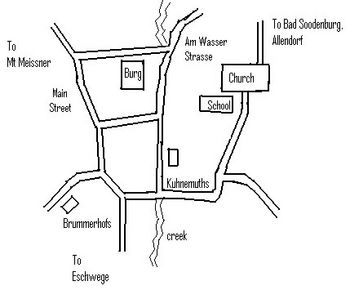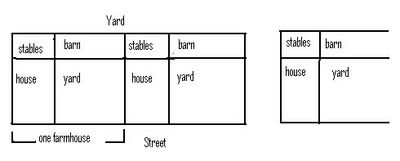Life in 19th Century Frankershausen
Jacob Kuhnemuth and his wife Dorothea Elisabeth Schindewolf were both born in Frankershausen and lived there for half a century before emigrating from Germany. They lived in one of the half-timbered houses on Am Wasser Strasse (On the Water Street), named for the creek that ran through the middle of the village at that time. The population of Frankershausen was about 300 at that time, and the preponderance of families were named either Kuhnemuth or Schindewolf. The Kuhnemuths lived on the east side of Frankershausen, and the Schindewolfs on the western side. On the southease hill was the church, built of sandstone, with a fifty foot tower. Just behind it was the school. The Kuhnemuth children were baptized in this church and educated at this school.
When the village was founded, the houses were clustered together near the church, for safety from marading bands of robbers, or armies. The farm fields were developed beyond town as the forests were cleared. As more and more fields were cleared for farming, a family's holdings might lie in scattered parts of the surrounding area. As only the more successful farmers owned horses, others would use their milk cows to pull the wagons of grain to the barn, attached to the house in town, for thrashing. The village houses were built contiguously. One family's house, with stables at the rear, would be at a right angle to the attached barn. This L-shaped arrangement of attached buildings enclosed their yard. Their barn also attached to the stables of the next family's complex. On Am Wasser Strasse, the houses and yards faced the creek, with the series of stables and barns at the rear. The village ducks and geese flocked along the creek.
In the 1800's, the ruling noble family in the area were the Dornbergs, and the burg, or fortress, in Frankershausen belonged to them. It was at one time surrounded by water, as a "wasserburg". Now, for many years, it has been converted to an inn.
Since 1972 Frankershausen is part of a newly founded community of Berkatal, Werra-Meissner Kreis, County Kassel, State Hessen. The Kuhnemuth home was located at 49 Am Wasser Strasse in the 1850's. It still stands, although the house number has been changed to No. 7, and the creek has now been buried in pipes beneath the street. The date displayed on the old Kuhnemuth barn is 1741. When the house was visited in the 1990's, the property had been in the hands of the Hildebrandt family for several generations, perhaps since Jacob Kuhnemuth left for America in about 1856. The new owners reportedly found old letters stored in the attic or rafters, from Kenemuth cousins in America, one postmarked "North Eastern Pa." By the 1920's and The Great War, the correspondence died out.
Nineteenth century Germany was divided into many small states, mostly ruled by aristocrats who imposed many forms of taxes and licenses. The soil was quite poor and the farm fields, having been divided among sons for generations, were quite reduced in size. This situation was aggravated by the fact that the most fertile land was owned by the "Herren von Dorenberg", the large land-owning family. Most men therefore sought an additional source of income besides farming. Jacob Kuhnemuth apparently owned a good team of horses, as his occupation is noted in the records as "fuhrmann and handelsmann",, or "fuhrleute", a wagon driver and merchant. This was something more than a peddler of goods from house to house. More likely he had an established route between sources of materials and buyers, much as a modern day trucking company would operate. These wagoners took loads of coal and timber from the Mt. Meisner area to the town of Bad Sooden Allendorf, a salt springs area where brine was converted to salt. This valuable commodity for preserving food was then exchanged in southern Germany for wine from the Rhein and Mosel river valleys, or for colonial imported sugar and spices, or mineral water, or iron. This was one of the more profitable trades, and some of the fuhrleute eventually became rich independent merchants.
The town of Eschwege is located just east of Frankershausen, on the Werra river. A footpath that lead from Frankershausen down into the Werra River valley, about three miles away, was used by craftsmen who sold their wares in Eschwege and Bad Soodenberg. Frankershausen craftsmen made an excellent grade of horsewhips and of handwoven woolens, which were also among the merchandise traded by the fuhrleute. For some generations, this system of small crafts and manufactures plus the fuhrleute's transportation and trade routes provided a possibility of comfortable living. This system began to fray with the event of the Industrial Revolution. Factories replaced the cottage weavers and craftsmen, and railroads displaced the fuhrleute. Frankershausen was bypassed by the Frankfurt to Hannover railroad route. Jacob Kuhnemuth no doubt experienced failing fortunes and a growing concern for his sons' futures. When their daughter Anna Catherine and son-in-law John Frederick joined the Dieterich and Jung families from nearby Hitzerode in migrating to America, Jacob and wife Dorothea began the process of deciding, selling, packing, leaving family and native culture behind in exchange for a homestead of tillable land in Pennsylvania.
Sources
| Ref. Num. | Description | Image of original |
|---|---|---|
| 1 | The Kennemuths in America by Kermit Kennemuth, research manuscript. | |
| 2 | 1100 Jahre Frankershausen 876 - 1976, commemorating the 1100th anniversary of the founding of Frankershausen, festival week 19-28 June 1976. Published 3441 Berkatal 1, Berkastrasse 54.Vorbereitung. In German. | |
| 3 | Personal correspondence from Judy Etzel King, g-g-g-granddaughter of Anna Elisabeth Kenemuth. | |
| 4 | Research in Germany by Renate Shadla-Jakob, commissioned by Judy King. | |
| 5 | Personal communication from Pauline Reichard re. visit to Frankershausen, interview with the Hildebrandt family, photographs of the village and area. | |
| 6 | Research of Dr Kurt Guenther in Frankershausen and Hitzerode, Germany, commissioned by Wilda and Bill DeHart. |

